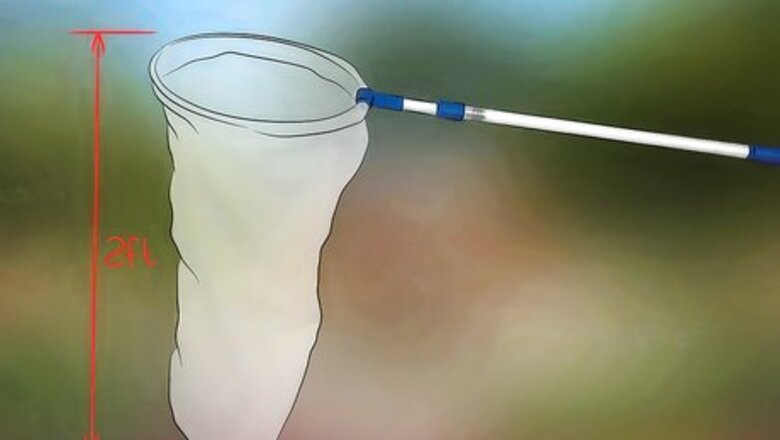
views
Catching a Butterfly With a Net
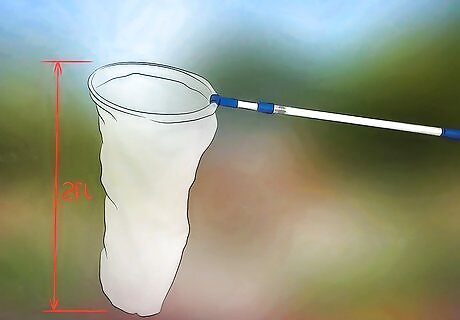
Buy a good net. Kids' nets are not actually good for catching butterflies. They are too short and can hurt the butterfly. A longer net is better, because you catch the butterfly in the netting, not on the hoop. Your net should be at least 2 feet deep. However, keep in mind, in some areas, you will need a permit to carry a butterfly net. Check with your local laws to see if it applies to you. Your hoop should be wide enough to make it easy for butterflies to fit through, though you don't want it so large that you can't handle it easily. Also, you should be able to see through the netting. The netting should be coarse, so you can move it through the air without much wind resistance. The handle should be sturdy enough that it doesn't break when you flip the net around.

Find a good place to look for butterflies. Woods are often good places to find butterflies, but your backyard can be just as good. If you plan to catch butterflies, you might consider planting flowers that local butterflies are attracted to. For instance, marigolds, milkweed, buckwheat, zinnia, and heliotrope are flowers that many butterflies are attracted to.
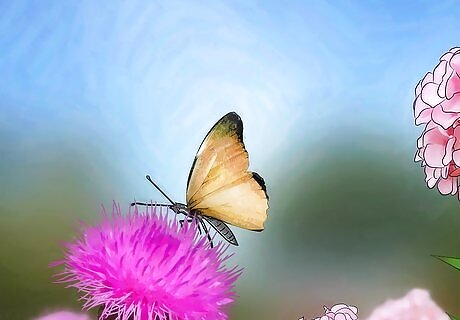
Look for butterflies that aren't in motion. You may have a vision of swooping your net through the air to catch a butterfly in flight. However, the reality is it's much easier to catch one that's stationary. Look for butterflies sitting on flowers, drinking nectar, or roosting. In tropical climates, you'll usually find butterflies roosting underneath leaves or branches, and you'll find them there in temperate climates, too, when it's raining or cloudy. Otherwise, you'll often find them roosting on the tops of grass or leaves in temperate climates. Remember that some butterflies will be camouflaged very well to blend in with their surroundings, so you'll need to look closely.
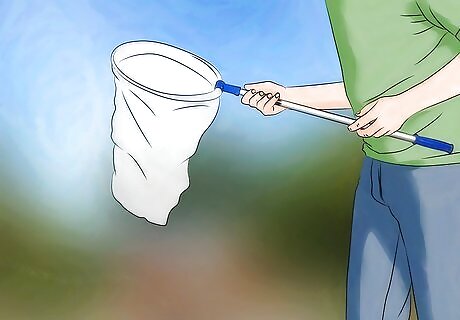
Sneak up on it. If you can, move in from the back of the butterfly, trying to quietly and slowly move in. Once you are in range, flip the net over the butterfly. Do it in one quick motion, so the butterfly doesn't move away before you've caught it.
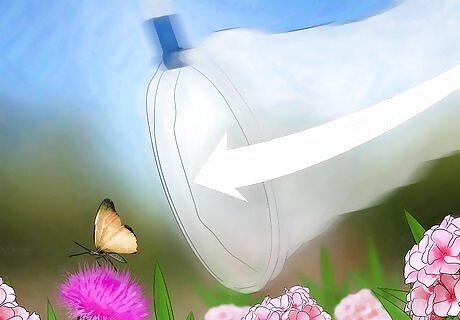
Catch one in flight. You can catch one in flight; it's just much harder to do. The best way to do it is to first sneak up on the butterfly from behind. Next, do a quick scoop to surround the butterfly with the net. Flick the net so it can't escape.
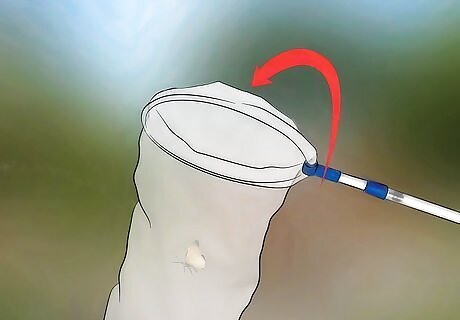
Fold the net over. Once you've caught a butterfly, fold the netting over the hoop. That way, the butterfly can't escape through the hoop. This is one reason why you want your netting so long. You can pull it over the hoop and not hurt the butterfly.
Dealing With the Butterfly
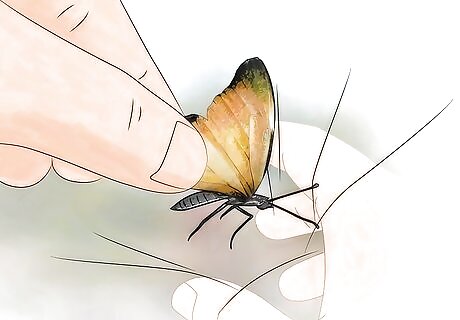
Grasp the butterfly. If you need to do so, you can handle the butterfly. Simply grab it lightly just above the body with the wings folded together. Unless the butterfly is very delicate, it won't be harmed by this operation. Monarchs, for instance, are sturdy. You can also turn it over to make it calm down.
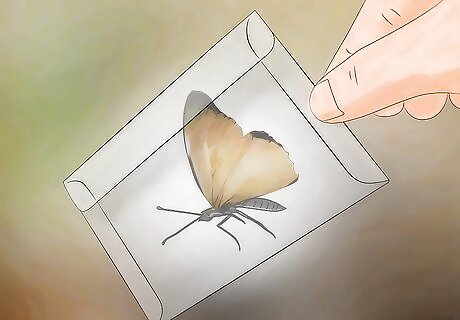
Put them away for later. You can store a butterfly in a glassine envelope, which is a stamp or coin envelope. These envelopes are semi-clear, made of a waxy paper. You can also simply use a small triangular envelope. Make sure to mark any information you need on the outside of the envelope in permanent ink. You may want to use a specimen number or note the date, time, and area you found the specimen. You may also want to note if the specimen was with a partner.
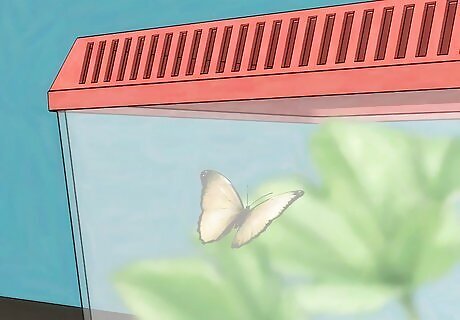
Transfer the butterfly to a cage. If you are going to keep the butterfly alive, you need to transfer it to a cage when you get home. Generally, the best cages for butterflies have netting or screens on the outside. You'll need to provide nectar or sugar water appropriate for the butterfly. Glass or plastic isn't as good because the butterfly can't walk on it. Some butterflies won't eat at all. However, most eat nectar or sugar water.
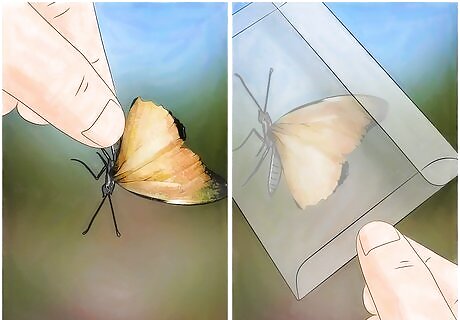
Kill the butterfly, if desired. You can kill the butterfly in the net so it won't damage itself. Simply squeeze the middle body segment (the thorax) hard between your fingers until the butterfly stops struggling. Then you can slip it in an envelope for later.
Collecting Caterpillars
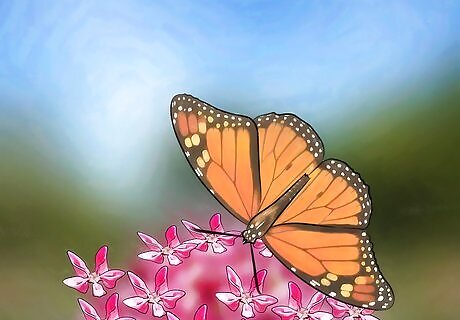
Find plants that the butterflies favor. For instance, milkweed is a common place to find monarch caterpillars. Look up the type of butterfly you want to find first, so you have an idea of what they eat, where they lay eggs, what the caterpillar looks like, and what the eggs look like. Look for feeding damage in the shade. On milkweed, for instance, milkweed bugs may damage the plant in the sun, but in the shade, it's more likely monarch caterpillar damage. Get in close. Some caterpillars will be pretty tiny, not bigger than 5 or 6 millimeters, though they can also get an inch or so long. The eggs are also fairly tiny. In the case of monarchs, they are tiny white balls. Don't take too many caterpillars from one spot. Leave some to grow up in the wild.
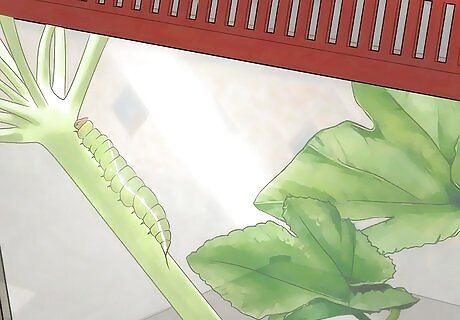
Transfer them to a feeding bucket. A five-gallon bucket is sufficient for keeping 5 to 10 caterpillars. The bucket should have plenty of what the caterpillars eat, such as milkweed leaves, and you should provide a variety if your caterpillar eats more than one kind of leaf. In addition, it should have a screen roof for ventilation, so that the feces from the caterpillars can dry out and not harm them. You can use a smaller enclosure, as long as you provide proper ventilation at the top. You can also place tissue paper or blank newspaper at the bottom to collect droppings.
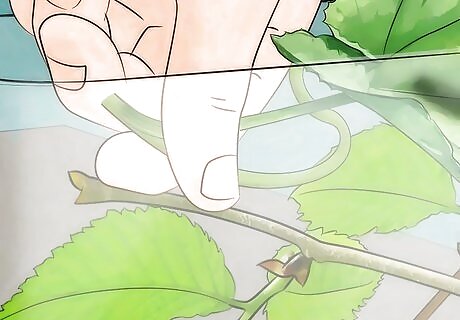
Replenish the food as needed. If you're putting leaves in the bottom of the bucket, you'll need to replenish them regularly. You can also put small branches in a glass of fresh water, which don't need to be replenished as often, as they'll stay good for longer. If you do put branches in water, try to block most of the top of the glass or jar, so the caterpillars don't fall in and drown. Consider rinsing leaves in water and leaving them wet. Doing so can provide the caterpillars with the moisture they need.
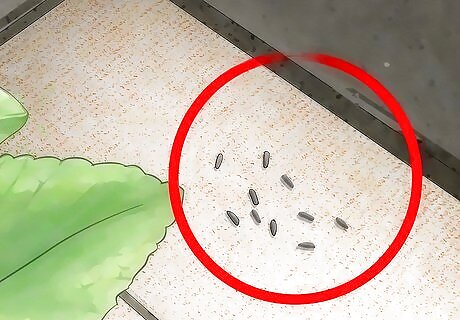
Clean out the cage. You will need to clean out the cage regularly. You can clean out the cage once a day. Remove the paper you used and replace it. Also, take out any dead or dry leaves, as caterpillars won't eat anything but fresh leaves.

Provide pupation sites. Most caterpillars prefer branches or leaves, so make sure to provide places for the caterpillar to pupate. Once they choose a pupation site, consider moving it to a different cage. You will want to keep this cage lightly misted. Your caterpillar will likely remain in this stage throughout the winter if it went into the pupation stage in the fall. It's not dead, just turning into a butterfly. Make sure the pupa is high enough. It should stay hung up (for most butterflies), giving the butterfly space to emerge. Hang up the leaf or stick if is too low to the bottom of the cage. You can also glue a cocoon up. Add a dab of low-temp hot glue to a piece of paper. Let it cool, but make sure to move while it is still liquid. Place the tip of the cocoon in the glue. Hold it there until it dries. Tape or pin the paper up so the butterfly has space to emerge.

Keep an eye out. Watch the chrysalis. When it changes color, to dark or translucent, the butterfly will emerge soon. Make sure to mist the cage. The butterfly will emerge in under a few seconds once it's ready, so you need to be prepared if you want to see it.



















Comments
0 comment